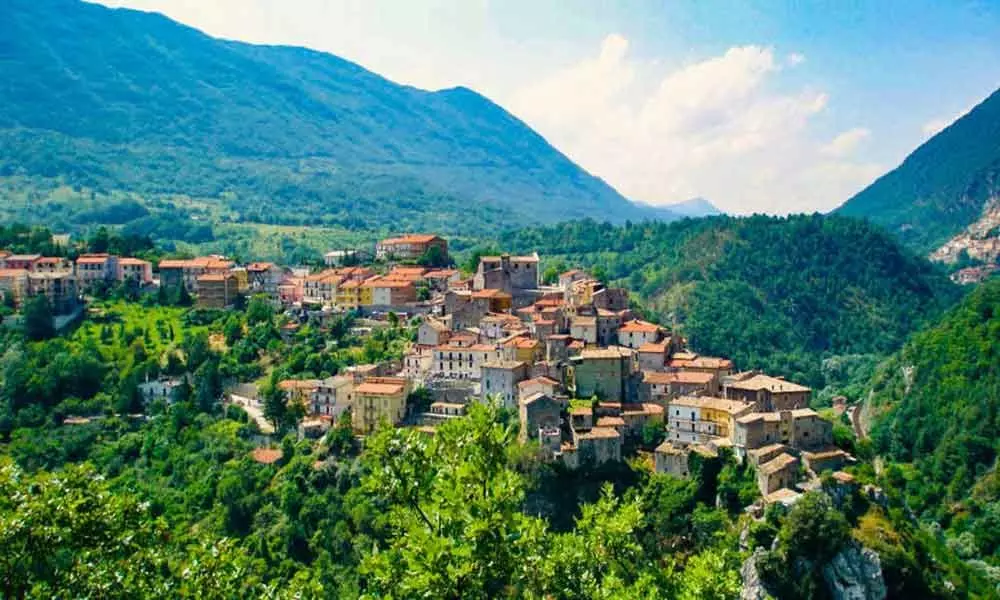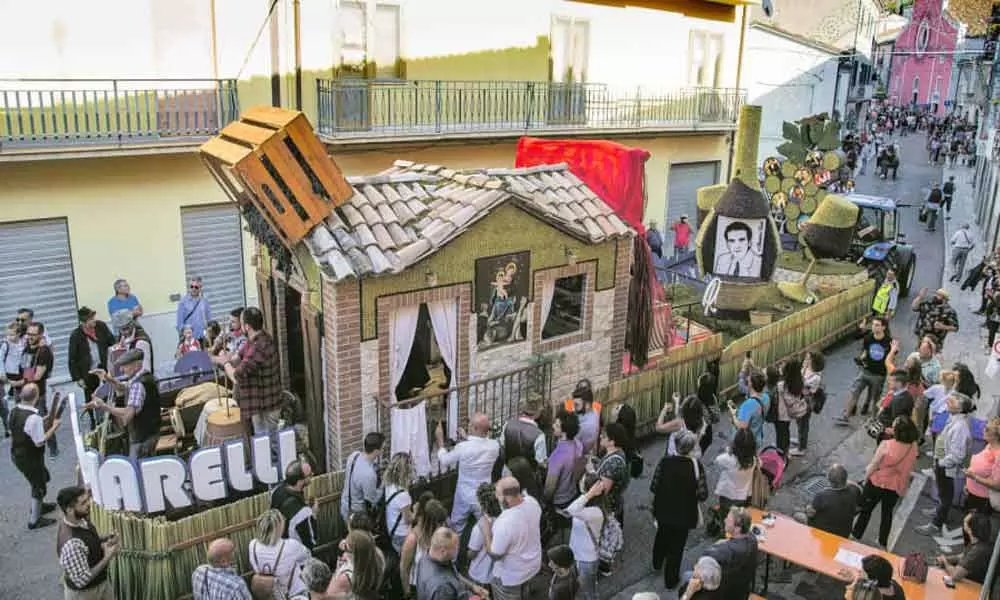Live
- ‘Get Set, Grow Summit 2024’ Focuses on Digital Detox for Families
- Stokes motivates his team to put in extra effort, says England pacer Potts
- From overcoming setbacks to leading India in U19 Women’s Asia Cup, Niki Prasad's amazing journey
- Driving Enterprise Security: Inside Venkata Reddy Thummala’s Leadership Journey
- Constitution debate: PM Modi hails 'Nari Shakti'; makes strong pitch for 'United Bharat’
- Abhijeet Bhardwaj: Revolutionizing Enterprise Analytics with Innovation and Expertise
- Bihar: Inquiry initiated against principal who went to buy veggies during school hours
- Press Sri Lankan Prez for release of Indian fishermen: TN Cong MP to EAM Jaishankar
- TN: DMK postpones executive meet due to heavy rains & Parliament session
- Porous silicon oxide electrodes can fix durability issues in batteries: Researchers
Just In
These Italian towns in Molise will pay you $27,000 to move there

When Italian villages began selling houses for $1, it seemed too good to be true. But the latest offer from Italy is enough to make even that deal look like a ripoff.
The region of Molise, a wild, beautiful but overlooked area that lies east of Rome, has announced it will pay people more than $27,000 to settle in one of 106 underpopulated villages in an effort to prevent their communities from dying.
Photography is now an essential part of any holiday, so here's a creative guide to taking the best pictures in locations like tropical Sentosa island.
Anyone who takes up the offer will receive 700 euros a month (about $770) for up to three years to help them settle in an area known for its green pastures, olive groves and snowy mountaintops.
There's a catch -- they'll also have to commit to starting a small business, in order to contribute to the local economy.
"I want my region to undergo a renaissance and avoid its authentic villages turning into ghost towns," Antonio Tedeschi, a regional councilor who came up with the idea, tells CNN Travel. "We need to safeguard our roots."
Young people and couples with children are particularly encouraged to apply to the scheme, which is to be officially launched on September 16.
Tedeschi, who was born in the small Molise village of Filignano -- home to barely 700 residents -- says he knows what it means to see old traditions and historical places fall into oblivion and wants to stop the decline in its tracks.
Photography is now an essential part of any holiday, so here's a creative guide to taking the best pictures in locations like tropical Sentosa island.
Anyone who takes up the offer will receive 700 euros a month (about $770) for up to three years to help them settle in an area known for its green pastures, olive groves and snowy mountaintops.
Now one of Italy's most depopulated regions, 106 of its 136 towns have fewer than 2,000 residents.
Many communities across Italy are at risk of being lost as younger people migrate to bigger towns and cities -- or abroad -- in search of work as Italy's fragile economy struggles to support its more remote, rural areas.
Recently, there's been a spate of villages from the northern Alps to the southern vineyards of Sicily, virtually giving away homes to anyone willing to spend the money on renovating them to move in.
Molise's offer has the potential to be the most lucrative yet for anyone willing to take the plunge.
So what exactly can applicants expect if they take the plunge? Here's a look at some of the most picturesque villages among those inviting people to move in.
Fornelli is known as the City of Oil because of the olive groves dotting a landscape that also harbors premium truffles and species of endangered legumes.
Nominated for the 2019's Italy's Most Beautiful Town contest, it has a medieval center that was once protected by a drawbridge and is now a web of narrow alleys and arched entrances.
Seven towers are incorporated in the town's defensive walls, within which cars and even motorcycles are banned, making it peaceful and unpolluted.
Clinging to the rocky cliff side of Mount San Marco, this village takes its name from the Italian word pietre, meaning "rocks."
The white-yellowish stone dwellings at the feet of a majestic castle contrast with the green-brownish stones covered in lush vegetation that cover the landscape.
Isolation has preserved the village from centuries of Barbarian raids and the doorways of homes and aristocratic buildings are adorned with weird stone images.
Clinging to the rocky cliff side of Mount San Marco, this village takes its name from the Italian word pietre, meaning "rocks."
The white-yellowish stone dwellings at the feet of a majestic castle contrast with the green-brownish stones covered in lush vegetation that cover the landscape.
Isolation has preserved the village from centuries of Barbarian raids and the doorways of homes and aristocratic buildings are adorned with weird stone images.
These villages are for ski lovers.
One of the attractions of Molise, Italy's second smallest region, is that it has everything in one place: sea, lakes, forests and even the Apennine mountain range.
Capracotta and Campitello Matese are the region's top winter sports resorts, pulling in snowboarders and cross-country amateurs.
Skiing pistes aren't as long nor as steep as those found in the Alps, but there's the added attraction of thick woodlands where wild animals still live, including bears.
It's hard to believe, but Molise rivals Rome or Pompeii for ancient architecture and archeological attractions.
The two small villages of Pietrabbondante and Sepino both contain the secret, largely unknown ruins of once-glorious citadels.
A large chunk of Molise used to lie within the kingdom of the fiery Samnite tribes who refused to bend the knee to Ancient Rome but were eventually slaughtered.
Pietrabbondante's archeological area, close to the town and set at an altitude of 1,000 meters, has a spellbinding view over Molise's rugged hills and features a sanctuary and several temples.
Saepinum, or Sepino's ruins, is incredibly well preserved with statues of imprisoned barbarians greeting visitors at the entrance.
Grazing sheep, cows and buffalo dot the bucolic landscape here.
It's still possible to spot forgotten dusty trails winding up the mountains and the ruins of a majestic Italic temple built in the third century BCE.
San Giovanni in Galdo is located near one of Molise's main routes used by shepherds to move their livestock between low and high pastures.
The old town, dubbed Morrutto or "broken walls" in local dialect, is a maze of caves and underground chambers.
Old festivals survive such as the performances of the Zig-zaghini folklore group, which enacts something known as the "anti-jinx dance."
The clear waters of its blue lake makes Castel San Vincenzo one of Molise's most visited towns by day-trippers.
Set in the Alta Valle del Volturno, it's known as the Valley of Faith, because monks and pilgrims have, for centuries, come here for meditation and prayer.
Today the nearby stunning abbey of San Vincenzo Al Volturno lures soul-searching travelers craving an unplugged stay and artists in need of inspiration.
The village, dating back to pre-Roman times, is a collection of pastel-coloured peasant houses connected by staircases and nestled at the feet of an overhanging fortress.
The town's symbol is a huge stone cross. Its belvedere piazza offers a unique panorama of surrounding meadows dotted with the ruins of Samnite towers.
Duronia is popular for guided trekking tours along rural routes.
The foodie Scattone festival celebrates an iconic pasta dish made with red wine and pepper that's said to offer strength and ward off influenza.

© 2024 Hyderabad Media House Limited/The Hans India. All rights reserved. Powered by hocalwire.com












